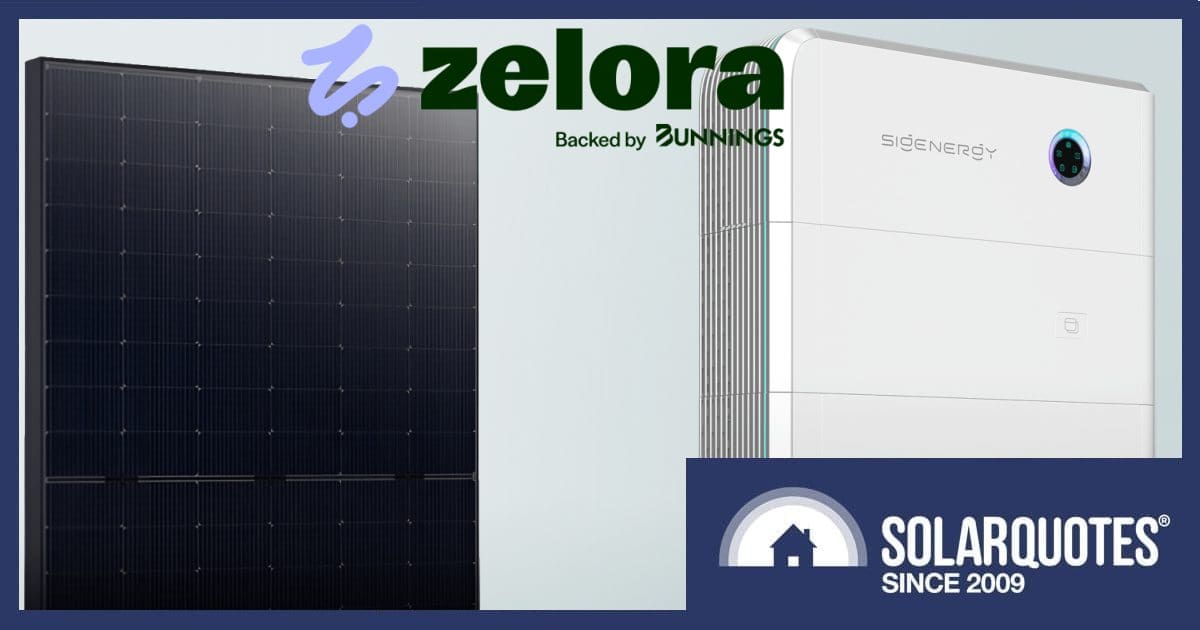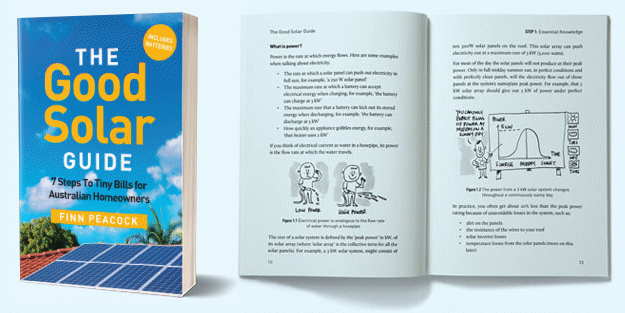
Australian hardware and homewares giant Bunnings is broadening its activities in the home electrification arena, backing a new brand offering solar energy and battery packages on a subscription basis or that can be purchased outright.
Initially available to Newcastle and metropolitan Sydney customers only1, the ‘Zelora’ packages were developed in partnership with Intellihub.
Established in 2018, Intellihub is probably best known for the provision of metering devices and services to dozens of energy retailers across Australia and New Zealand. The firm has delivered around 2.8 million smart meters to date. Under this arrangement with Bunnings, Intellihub is supplying, installing, managing and supporting the Zelora solar and battery systems.
“Many customers find home electrification complex and may not be aware of the benefits it can offer,” said Bunnings’ Chief Operating Officer, Ryan Baker. “Zelora has been developed to simplify the home battery and solar opportunity for customers in a cost-effective way.”
Zelora is a trademark owned by Bunnings used under licence by Intellihub.
What Does A Zelora Package Cost?
The following is indicative pricing for the various solar and battery packages as at July 23, 2025, but see notes below the table.
| Package | Small | Medium | Large | X-Large | XX-Large |
|---|---|---|---|---|---|
| Solar Capacity | 3.96 kW | 6.6 kW | 8.8 kW | 10.56 kW | 13.2 kW |
| Battery Capacity | 7.8 kWh | 10.4 kWh | 13 kWh | 15.6 kWh | 23.4 kWh |
| Monthly Sub. (From) | $112 | $136 | $157 | $174 | $202 |
| Minimum Cost (10 yrs) | $15,058 | $18,284 | $21,108 | $23,393 | $27,157 |
| Purchase outright | $11,159 | $13,982 | $16,268 | $18,016 | $21,376 |
Notes:
- Pricing includes standard installation, government rebates and a ‘CEFC discount’2 on the subscription plan available for properties valued at less than $2.5m.
- Monthly subscription fee increases 2.5% each year (factored into minimum cost over 10 years in table above).
- Buy outright price is for hardware and installation only and does not include Zelora monitoring and optimisation services.
- Solar-only and battery-only packages are also available.
- There will be extra costs associated with any necessary upgrades, such as a switchboard upgrade.
- There may be additional costs based on eligibility criteria for government rebates and CEFC discount, and property-specific installation requirements (such as two-storey homes).
There’s a significant difference between the total cost under the subscription model vs. buying a system outright — 27% to 35% more depending on the package.
A point of difference between the two is that the subscription package also includes Zelora monitoring and ‘Smart Energy Optimisation’, which Zelora says analyses household electricity consumption patterns and instructs the battery to charge or discharge at optimal times to achieve the best savings. But the battery provided (see below) also includes its own native applications covering these functions.
The deposit for systems under the Zelora subscription plan is 2 months, but this also covers the first 2 months of subscription. For customers who choose to purchase outright, the deposit is 10% of the total price.
What Hardware Do The Packages Include?
The Zelora solar and solar/battery packages are comprised of:
- DAS solar panels: 25-year product and 30-year performance warranty.
- GoodWe hybrid inverter: (solar-only packages) 10-year warranty.
- Sigenergy Sigenstor battery: 10-year product and performance warranty.
- Sigenergy gateway: Warranty not mentioned, but Sigenergy indicates 2 years (Correction: Updated warranty document here states 5 years as standard, with option to extend another 5 years for an added cost).
Another warranty item is on workmanship; which is 5 years.
What Happens After The 10 Years?
According to the Zelora website, ownership will transfer to the customer at the end of the contract. Until that time, the solar and battery system is owned by Intellihub. It’s worth noting insurance is left to the homeowner, and home insurance is needed to install a Zelora system.
If cancelling a subscription before the 10 years is up, the payout penalty is proportional to the remaining hardware and installation costs. If a Zelora customer sells their home before the 10 years is up, the options are to pay out the contract or transfer the remainder of the contract to the new owner.
Is Zelora A Good Deal?
As mentioned, the additional cost of the subscription model is significant compared to buying outright, and a good solar/battery installation is more than just about the components used. Install quality plays a big role as does after-sales support, which remains to be seen.
We’ll see what the feedback is once some of these systems are installed and have been running for a while. Hopefully, it’s a smoother rollout than for Bunnings’ recent move into home EV chargers, which SolarQuotes in-house installer Anthony Bennett had quite a few concerns about.
It’s also worth noting the cheapest option of 3.96 kW of solar is quite tiny by the standards of 2025, especially when paired with a battery. That 7.8 kWh battery will eat up a household’s one opportunity at the federal battery rebate, which forever rules out making the most of the incentive for a larger battery that offers more significant savings down the track.
In any case, it’s always a good idea to get several quotes in order to make a more informed purchase decision; bearing in mind many installers also offer $0 up-front payment plans these days. And it’s certainly wise to get a basic understanding of solar and batteries before making any commitment, as you’ll be living with your decision for a long time.
It’s also worth fiddling with the SolarQuotes solar and battery calculator to get an idea of how the numbers stack up in your circumstances.
Footnotes
- No word yet if/when Zelora may be offered elsewhere in Australia. ↩
- CEFC stands for Clean Energy Finance Corporation, an Australian Government funded specialist climate investor. I don’t remember seeing anything about the CEFC funding such an initiative — but maybe it was all commercial-in-confidence at the time and we will hear about it soon. ↩

 RSS - Posts
RSS - Posts



Sigenergy in WA. Delays not approved as yet?
10kw 3ph. 24kwh bat and Gate.
I’m told Clean Energy Council have not approved for WA as yet.
What appears to be the hold up, can anyone shed light please?
Let’s Wait Awhile longer.
I agree, why o why is WA taking so long to accept the sigenergy battery?
I’m on hold waiting to get my installation?
What’s the problem?
I may have it wrong its Synergy WA testing and approving the VPP connectivity.
The approved list is sitting in Synergy : Supported Solutions List (SSL)
Both Tesla and Sigenergy are not in it?
I really would like a battery but fear the government will retrospectively make it mandatory to be part of a VPP.
You do have to have mild suspicion about the terms “must be VPP capable, but you don’t have to join a VPP”.
You have to wonder about a future mandated (yet) on the end of that being possible some day, if a power ’emergency’ means govco deems some sort of national action is required.
Smart meters mean just about anything is possible with all your homes power related infrastructure.
But in reality once a battery is charged daily, they are at least going to get overproduction feed in to help the grid, and there are signs VPPs are getting more competitive / attractive.
The likes of Amber, LocalVolts models, sees some retailers now starting to offer nil FITs during solar soak, and higher FITs in the peak evening.
Just be careful that you can dump power fast during short windows like 5 minute Amber spikes.
I personally feel retailers with a plan / tariff / time structure to suit an individual’s power usage / needs is enough to keep you fairly bill neutral or a little in credit.
This state by state, DNSP by DNSP incongruous rabble of rule and policy setting is holding back the grid transition and frustrating both consumers and suppliers.
If nation wide standards were adopted before new initiatives are rolled out, productivity would be improved.
WA= Wait Awhile
Given the relative sizes of PV and battery capacity in the table, I see this exercise as more VPP arbitrage oriented, rather than cost effectively cycling the battery from PV input on a daily basis.
The size of PV array required for fully electrified households with EV is significantly larger than the sizes tabulated.
Bottom line: For fully electrified residences; Insufficient PV capacity, or you think that VPP participation will make it worthwhile over the next decade.
That said, the scheme may well suit some strata-titled situations with limited PV mounting space.
For residences yet to fully electrify, the capacities may work out in the near to medium term, but an upgrade may be necessary before the 10 years are up.
Our household consumption went from 14kWh per day pre-electrification to 34 kWh per day post-electrification and that covers almost all hot water, cooking, refrigeration, reverse cycle air-con, lighting, and transport
Good points John,
My seat of the pants impression is that all the systems mentioned are too modest.
“Sigenergy gateway: Warranty not mentioned, but Sigenergy indicates 2 years.”
Two to three months ago, Sigenergy increased the factory warranty on the Gateway products to be 5 year, whilst also adding an optional 5 year warranty product that would see the overall warranty be 10 years (in line with the inverter and batteries), if taken up.
Hi Justin, thanks for flagging this. I’ve corrected the article.
I’m sure they will get a few customers.
Quite a few people will be more comfortable dealing with a large well known organisation rather than a small business they probably have no previous knowledge of.
The prices dont look terrible, my concern would be more who they might decide to sell out to if they get sick of managing it all. (EG Tesla’s recent sell out of their public housing VPP system down south to AGL)
I guess for a quarterly XX-large system payments of $606 would normally see such a household with that usage need pretty much eliminating a bill of close to $1000 + a quarter (and growing), plus blackout protection / convenience, so the carrot is there for those that don’t mind such a payment concept.
10 years is a long time to have such an ever compounding payment hanging over your head.
What happens when one want to sell and move on ?
They must have a policy for that, removal would not be an option.
Also in the fine print if payments are missed, there will likely be quite oppressive charges.
If you do an NPV calculation on the 10 year payment plan, the “real” cost of the payment plan is only about 72% of the Minimum Cost 10 years. (I used a 6% discount rate assuming that’s what you could otherwise earn with money or if you borrowed it). 72% of the 10 year cost is actually cheaper than the outright purchase cost from them now so this is quite cheap finance. This also doesn’t account for whatever you may save in electricity costs over the 10 years; so it actually looks like fairly good deal. The cost per installed kWh gets cheaper as you go bigger and ends up under $1k/kWh so doesn’t seem too bad for a quality solar and battery system.
I have a smart meter, installed and monitored by IntelliHub, on behalf of SAPN and my retailer. I have no direct contact with IntelliHub but the interactions via my retailer have been underwhelming, to put it politely.
Their lack of technical ability to solve what I thought was a simple request, does not inspire confidence that they will be able to manage a home battery installation and maintenance properly. It might have just been an initial unwillingness to tend to my request, but only after approaching the Water & Electricity Ombudsman (SA) did they eventually manage to do what I had requested many months prior.
Personally, I would watch the reviews carefully before signing up.
Sorry to hear that, but it’s everywhere around these days, lots of hype and little delivery.
Thanks for passing it on a great alert to us all.
My one positive reflection is that it could get some good traction with landlords, thereby helping renters who have been locked out of the savings from solar (and participation on the transition).
The ‘Zelora by Bunnings’ website has a page specially for that “in construction” that also mentions tenants. I could see the offering being a good, one-stop-shop, $0 upfront option for landlords (perhaps prompted by tenants) to finally get on board. It at least looks like pretty good kit, if a little undercooked on the battery side.
My one annoyance is lack of clarity about whether “subscription ” amounts to a VPP? I.e. are they going to flog the battery, leave you empty when you might not want to be, charge with coal-fired electrons overnight, etc? Given the justifiable distrust in VPPs, is Bunnings just not putting that on the tin?
Early this year or late 2024 solarqutes installed big Sigenergy battery with all the fruit. What happened have I missed any assessment of the testing with the unit as installed.
Some update would be helpful to us potential end users out here in battery land. Is it functioning as planned? Any news no matter how minor, did it fail?